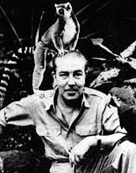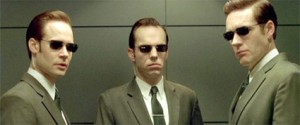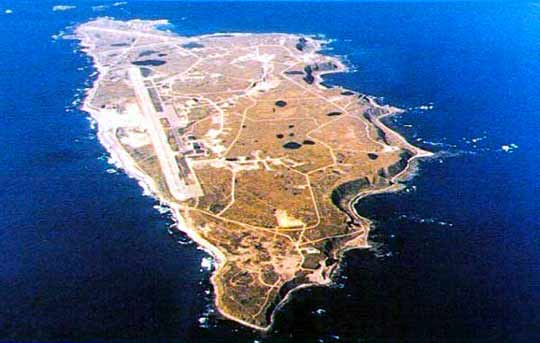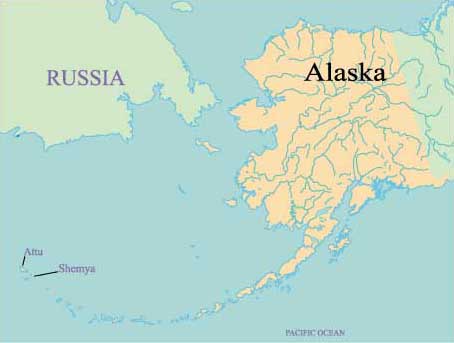Island of Shemya, Alaska
 Ivan T. Sanderson, a well-known zoologist and frequent guest on Johnny Carson’s TONIGHT SHOW in the 1960s (usually with an exotic animal with a pangolin
Ivan T. Sanderson, a well-known zoologist and frequent guest on Johnny Carson’s TONIGHT SHOW in the 1960s (usually with an exotic animal with a pangolin
or a lemur), once related a story about a letter he received regarding an engineer who was stationed on the Aleutian island of Shemya during World War II. While
building an airstrip, his crew bulldozed a group of hills and discovered under several sedimentary layers what appeared to be human remains. The Alaskan
mound was in fact a graveyard of gigantic human remains, consisting of crania and long leg bones. The crania measured from 22 to 24 inches from base to
crown. Since an adult skull normally measures about eight inches from back to front, such a large crania would imply an immense size for a normally
proportioned human. Furthermore, every skull was said to have been neatly trepanned (a process of cutting a hole in the upper portion of the skull).
In fact, the habit of flattening the skull of an infant and forcing it to grow in an elongated shape was a practice used by ancient Peruvians, the Mayas, and the
Flathead Indians of Montana. Sanderson tried to gather further proof, eventually receiving a letter from another member of the unit who confirmed the report. The
letters both indicated that the Smithsonian Institution had collected the remains, yet nothing else was heard.
Ivan T. Sanderson, a well-known zoologist and frequent guest on Johnny Carson’s TONIGHT SHOW in the 1960s (usually with an exotic animal with a pangolin or a lemur), once related a curious story about a letter he received regarding an engineer who was stationed on the Aleutian island of Shemya during World War II. While building an airstrip, his crew bulldozed a group of hills and discovered under several sedimentary layers what appeared to be human remains. The Alaskan mound was in fact a graveyard of gigantic human remains, consisting of crania and long leg bones. The crania measured
from 22 to 24 inches from base to crown. Since an adult skull normally measures about eight inches from back to front, such a large crania would imply an immense size for a normally proportioned human. Furthermore, every skull was said to have been neatly trepanned (a process of cutting a hole in the upper portion of the skull).
In fact, the habit of flattening the skull of an infant and forcing it to
grow in an elongated shape was a practice used by ancient Peruvians, the Mayas, and the Flathead Indians of Montana. Sanderson tried to gather further proof, eventually receiving a letter from another member of the unit who confirmed the report. The letters both indicated that the Smithsonian Institution had collected the remains, yet nothing else was heard. Sanderson seemed convinced that the Smithsonian Institution had received the bizarre
relics, but wondered why they would not release the data.

We are here because of you, Mr Anderson. We’re here to take from you what you tried to take from us.
He asks, “”…is it that these people cannot face rewriting all the textbooks?””
In fact, the habit of flattening the skull of an infant and forcing it to
grow in an elongated shape was a practice used by ancient Peruvians, the Mayas, and the Flathead Indians of Montana. Sanderson tried to gather further proof, eventually receiving a letter from another member of the unit who confirmed the report. The letters both indicated that the Smithsonian Institution had collected the remains, yet nothing else was heard. Sanderson seemed convinced that the Smithsonian Institution had received the bizarre
relics, but wondered why they would not release the data. He asks, “”…is it that these people cannot face rewriting all the textbooks?””
http://chapmanresearch.org/PDF/There%20Were%20Giants%20on%20the%20Earth.pdf
PHOTOGRAPHS OF ALEUTIAN ISLAND ARCHEOLOGICAL SPECIMENS
Oscar T. Lewis collected the specimens on the southeast side of Shemya Island, Semichi Island Group, Aleutian Islands. The Air Force destroyed the site when it built a base. Included are bone, ivory, and stone tools and human skeletal remains. The objects are National Museum of Natural History accession 390,872.
DATE: 1940s
QUANTITY: 40 prints
CALL NUMBER: Photo Lot 92-11
http://www.nmnh.si.edu/naa/guide/_a1.htm
“Notice is hereby given in accordance with provisions of the Native
American Graves Protection and Repatriation Act (NAGPRA), 43 CFR 10.9,
of the completion of an inventory of human remains and associated
funerary objects in the possession of 611th Air Support Group, United
States Air Force, Elmendorf Air Force Base, AK.
A detailed assessment of the human remains was made by the W.H.
Over Museum, South Dakota State Archeological Research Center, and
611th Air Support Group, USAF professional staff in consultation with
representatives of the Aleut Corporation, and the Aleutian Pribilof
Islands Association, Inc.
In 1943, human remains representing one individual were uncovered
during a legally authorized runway construction project on Shemya
Island, AK conducted by Mr. C.B. Kimbrough, a contracted civil engineer
with the Baker Engineering Company, Rochester, PA. In 1944, these human
remains were donated by Mr. Kinbrough to the Dakota Museum, University
of South Dakota, Vermillion, SD (now known as the W.H. Over Museum). No
known individual was identified. The 32 associated funerary objects
include stone projectile points and animal bone tools related to sea
and land hunting and fishing.”
www.cast.uark.edu/other/n…c0339.html
Now we get the full picture of what has happened with the Shemya remains. Some were taken by the Smithsonian and now in their collection (NMNH) whereas atleast one more has been given to NAGPRA. They were obviously Aleutian, Native American remains – but of colossol size evidently.
So here again, we have a story of giants found, then stored away and reburied once again….
40 prints of these giants exists, these are of vital evidence and public information, information that is suppressed typically by nature-based museums. Happy hunting. ~Chris L Lesley


Shameful how this was done and continues to be kept from all of us. Even here where i live, the legacy of smithsonian and govt “conservationist” is evident. i wish we could bring this to light.
We are. Chris Kent we need people posting links from these types of sites to others, to blogs, in debates. We need people to set up speaking engagements, forums, etc. We need people researching and volunteering their talents. Every action ripples and multiplies.
my dad was in Alaska before and during WWII. he had arrow heads and tools collected from shemya. I have been trying to find out about any people in history that lived there. so I could find out how old they are. can you help me?
It would be likely that they are indeed giant artifacts although the inuits have been all over that region as well. If they were from Shemya there is the possibility. Normally i talk about donations, but seeing how they are from your dad, i would buy a display case and keep them show how much you appreciate the gift by displaying them at home.
~Chris L Lesley
I have been excavating (legally) archaeological sites on Shemya for almost 30 years. We have excavated in every known site on the island. I have personally handled all of the artifacts and bones recovered. I have examined every collection of Shemya artifacts I can find. I have read several letters by people who worked on Shemya and donated their collections to various museums. None of them even hint at anything unusual. Our work has upended the “traditional’ views of western Aleutian prehistory and continues to do so. I have also participated in the legal reburial of several people who were ripped out of their graves by construction and by looters. The NAGPRA case above was of a perfectly ordinary human being. There is no credible evidence of any kind giant human-like beings ever living on Shemya. None. The human skeletons recovered are all normal. The artifacts recovered are all human sized. The houses etc all perfectly normal.